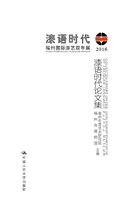
IV.Lacquer art of foreign countries
As with the previous international lacquer exhibition,artists from Japan,South Korea,Vietnam,America,European countries have shown their consistent level and characteristics,especially artists from Japan and Vietnam.The tradition of learning and teaching is conducted uninterruptedly by dozens of generations of descendants in the field of lacquer art in Japan.They absorb the context of western modernism and post-modernism,and remain the expression and confidence of oriental media material at the same time.It may be the most vivid reflection of “Japanese spirits,but Western materials” proposed by Japanese ideologist Fukuzawa Yukichi in the field of lacquer art in Japan which greatly stresses classic inheritance.Lacking uninterrupted accumulation by dozens of generations,Chinese lacquer art ushers in the beauty of western style in the background of deep cultural fault of lacquer,which is the context of weak culture facing the modernity of Chinese lacquer art home and abroad.At the beginning of last century,Shen Fuwen and Li Zhiqing successively learned in Japan,which marks the end of cultural fault of lacquer.
If Japan lacquer art is a mirror,Vietnam lacquer painting is another good example for China's lacquer painting.There are a dozen of lacquer painters who were born in 1900 or 1910s,and they are Ruan Jiazhi's contemporaries,such as Fan Hou(1903——1995),Chen Wenjin,Ruan Wengui and Chen Tingshou.However,there are only two or three lacquer painters in the same period of China,such as Shen Fuwen.It is noticeable that the first generation of lacquer painters in Vietnam has completed the important process of finding themselves by learning from the West in the 1930s,while leaders of lacquer painting in various regions of China are still in their childhood or juvenile period in 1930s.The work describing great scene of national temple fair was completed by Ruan Wengui at 19 years old.They own instinct premature wisdom in materials,techniques and national awareness of patterns of lacquer paintings.The invited three generations of Vietnamese lacquer painters are representatives to keep national characteristics in the influence of western paintings.
To varying degrees,Japan and Vietnam both present national confidence in lacquer art.It should be said that if people are more confident in their culture with educated quality and accumulation,they will be more comfortable in art creation.
As an important center of lacquer art in modern and contemporary times,Fuzhou owns a good tradition of lacquer culture.Studies on lacquer language in different stages all present different thinking models: from “studying the nature of things” proposed by folk workshops represented by the Shen family,to “information aggregation and problems tackling” of lacquer art research institutes after the foundation of the People's Republic of China,to “point-line-surface creativity” of lacquer art studios after the reform and opening up,until the model of “from technology form to subject form” of colleges and universities in the new century.With rich lacquer techniques and lacquer language and wide and various platforms for lacquer exchanges,Fuzhou will absolutely keep its proper height and spirit in the era of lacquer language,and continue to promote the prosperity and development of China's lacquer art.
注释
[1]ZHOU CHANGZHONG.Modernization Transformation of Chinese Traditional Culture[M].Shanghai:SDX Joint Publishing Company,2002:407.
[2]ZHOU CHANGZHONG.Modernization Transformation of Chinese Traditional Culture[M].Shanghai:SDX Joint Publishing Company,2002:20.
[3]Comprehensive Dictionary of Form, Sound and Meaning[M].Beijing:Zhonghua Book Company,1989:246.
[4]SOETSU YANAGI.The Folk Art Theory[M].Nanchang:Jiangxi Fine Arts Publishing House,2002: 344.